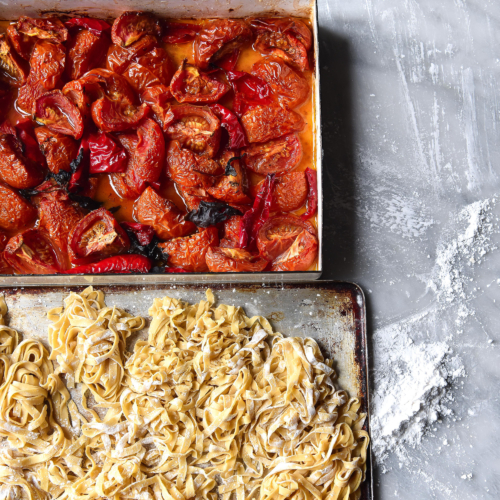
Gluten free egg pasta
All cup measurements are in Australian cups
Equipment
- Pasta machine (or a lot of time and patience)
Ingredients
- 240 g (1 1/4 cups) fine white rice flour
- 60 g (1/2 cup) tapioca flour
- 1 teaspoon xanthan gum
- 3 extra large eggs
- 1/4 -1/2 cup water only as necessary
Instructions
- Combine the flours and xanthan gum in a large mixing bowl. You can also do this on the table (as is traditional) but I always get excited and under-form my flour well. Either way, form a well in the flour and add in the eggs. Use a whisk to break up the yolks, and then begin to incorporate the eggs into the flour.
- Once the eggs are mostly incorporated (the mix will look clumpy) add in the water, using one hand to bring the dough together. Keep adding water only as necessary, noting that you really need to work the dough to bring it together. If you’re cheating by adding extra liquid, the pasta will be a lot harder to work with. Best to put in the effort early. The dough should be stiff and firm with a drier surface but with little to no dry flour in the bowl.
- Once you have brought the dough together into a relatively smooth ball, tear off a piece and cover the remaining pasta in cling film or a slightly dampened tea towel.
- Lightly flour the bench with tapioca flour, using as much as necessary, whenever necessary.
- Use your rolling pin to roll the piece of dough thin enough to get through the thickest setting of your pasta machine. After getting it through the thickest setting (mine is a 7) run it through the machine again. Continue rolling it through on decreased width settings until it’s thin enough for your tastes, noting that it swells during cooking (so go a little thinner than you think.) I like to get mine through smoothly at setting 2 or 3 on my Jamie Oliver machine.
- I don’t have a special technique – I keep running the pasta through until it’s smooth and (ideally) has relatively straight edges. You can save a bit of time and sanity by trimming the edges of each piece you roll out before putting it through the machine. You won’t toughen the pasta from rolling, so you can re-roll as often as you see fit. If it’s wonky, you can start fresh. You can also add extra water to very dry pieces that have toughened from being rolled out.
- Once the sheet of pasta is thin enough, put it through the fettuccine setting. Arrange into a little loose nest and set aside.
- Repeat with the remaining pasta dough until you have used it all. From here, you can either cook immediately, refrigerate overnight as nests, or freeze as nests. I find it tastes best fresh, but they’re all delicious regardless.
- To cook, bring a large pot of very well salted water to the boil. Add the pasta and use tongs to gently but thoroughly separate the strands. This is particularly important if you made them the night before, as they have the tendency to stick together. Cook the pasta for 2-3 minutes, until it’s lightly chewy but cooked through. If in doubt, pull it out – homemade pasta doesn't take long.
- Leftovers keep well in the fridge for a day or two and can be frozen. The pasta might be a little fragile after cooking and freezing, so I recommend either freezing it raw or using it up within a few days.
Tried this recipe?Let us know how it was!